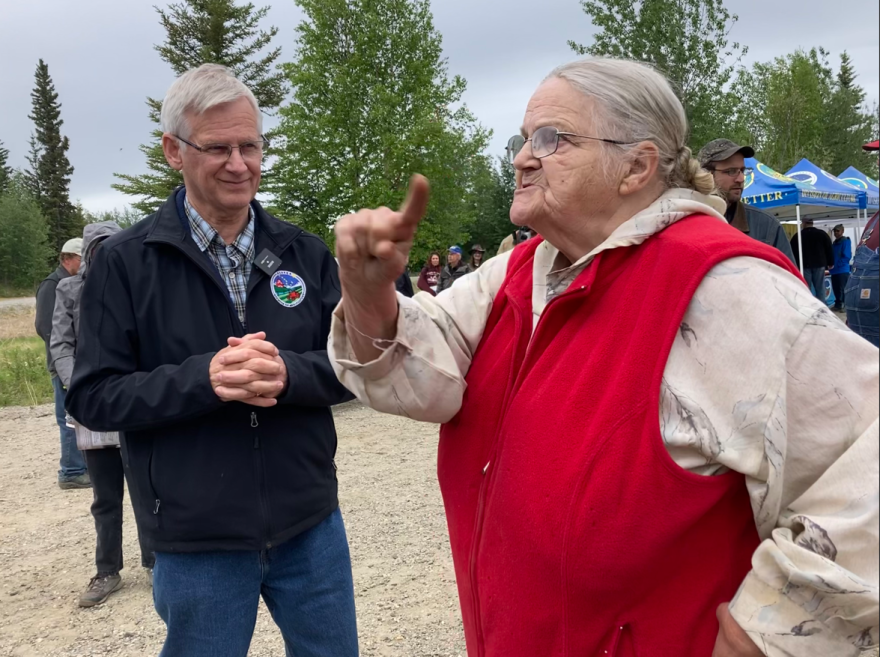State needs more feedback, completed studies before continuing ag project development, some residents say
Several Nenana-area residents are asking the state to delay land sales in a 140,000-acre agricultural project just west of the town. They say the state should talk further with local residents and complete studies on the ag project’s soils and resources before continuing the sales.

The state held its first auction last month for 2,000 acres the Nenana-Totchaket Agricultural Project, as part of what state officials call an effort to improve Alaska’s food security. But many area residents say they and their forebears harvested food from the land and its streams long before the project was proposed. And they doubt it will yield more food security.
“When I grew up there, it was just bountiful resources. We lived comfortably off the land,” says Eva Burk, who grew up on land that’s now within the ag project.
Burk is Dene Athabascan, and she and her family, like many other area residents, spent summers at fish camp and winters working a trapline. But she says fish and wildlife populations have for decades been declining.

“We lived comfortably off the land,” she said in a recent interview. “You just can’t do that anymore, because the resources are not there.”
Burk thinks that’s mainly because of poor state management, along with climate-change impacts. She says if the state was really interested in food security, it would consider the impacts of the large-scale development, and reconsider plans to clear land and build roads throughout it.
“If we’ve already seen a decline in resources in my short lifetime, then definitely putting more infrastructure and more people is definitely going to have a bigger impact,” she said. “I’ve already seen it with my own eyes.”
Fairbanks State Fish and Game wildlife research biologist Tom Paragi says wildlife populations can rise and fall for many reasons, including wildfires. Paragi says another may be a new bridge over the Nenana River that’s made access into the ag project easier.
“So, there’s going to be more non-local people that may be going out into that area now,” he said. “So there you’re going to be setting up competition for hunting and trapping, things like that.”

Nenana resident Kat McElroy agrees, and thinks that’s one of the ways the project may actually reduce food security.
“That land out there is the grocery store for a large segment of the population,” she said. “They have subsisted out there for generations.”
McElroy and Burk and others say much of the ag project land is not suited for agriculture, and they worry too much of that land is being sold for farming and livestock. They both support agriculture -- McElroy operates a farm and Burk runs a community garden and fish wheel and she’s studying for a master’s degree on Natural Resource and Environment from University of Alaska Fairbanks with focus on sustainable agriculture and community development. They both say the state is moving too quickly on the ag project without considering alternative ways to develop it. And, Burk says, without completing studies on impacts on the land and its resources.
“You need to slow down, because you need to know your soils, and you’re still doing that (study),” she said. “You need to slow down because you need to know where your fish and wildlife are. And you’re still doing that (study).”
The state held its first ag project land auction last month, a 2,000-acre offering that’s within the 30,000 acres to be developed as part of Phase 1. State Agriculture Division Director Dave Schade says the state is planning another for next year and beyond. He says the state has studied the land and conducted surveys on it, including photographic and with Lidar laser-sensor. But he acknowledges some studies, like the one on soils, are incomplete.

“When we have the first full 30,000 acres of the soil surveys, we’ll do some more analysis,” he said in a recent interview.
McElroy also faults state officials for promoting so-called “industrial agricultural,” large-scale monoculture development that’ll degrade the soils and shut out the locals from buying land.
“Industrial agriculture has a really bad reputation for destroying land bases,” she said, “and those concerns just weren’t listened to.”
The state offered 27 lots in the first land auction, ranging in size from 21 acres to just over 300 acres. Schade says the Agriculture Division has invited public feedback on the project, held several meetings and adjusted its plans. And he says there’ll be more chances to consult with the public in between land sales, especially from those who want to invest in the ag project.
“This is a small set, 2,000 acres, to get feedback from the market on what they want and how we can make this work,” he said. “If people don’t want the land and they don’t bid, well then we know we don’t have it right.”
Schade says state officials have been studying the project ever since it was proposed 30 years ago, and now they want to move ahead on it. But Burk says the state’s determination to move ahead without completing studies and further considering the communities’ concerns shows that its leaders are more interested in selling the land than in protecting it.
Editor's note: This story was revised to clarify that the Nenana-Totchaket Ag Project totals 140,000 acres, but only about 100,000 is planned for development.



